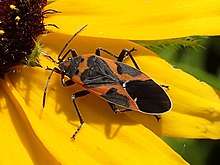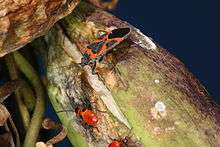Lygaeus kalmii
Lygaeus kalmii, known as the small milkweed bug or common milkweed bug, is a species of seed bug in the family Lygaeidae. It is found in Central America and North America.[1][2][3]
| Lygaeus kalmii | |
|---|---|
 | |
| Scientific classification | |
| Kingdom: | Animalia |
| Phylum: | Arthropoda |
| Class: | Insecta |
| Order: | Hemiptera |
| Family: | Lygaeidae |
| Genus: | Lygaeus |
| Species: | L. kalmii |
| Binomial name | |
| Lygaeus kalmii Stål, 1874 | |


Taxonomy
Lygaeus kalmii was first formally named in 1874 by Swedish entomologist Carl Stål in his Enumeratio Hemipterorum.[4][3]
There are two recognized subspecies:[3]
- Lygaeus kalmii angustomarginatus Parshley, 1919 – eastern small milkweed bug
- Lygaeus kalmii kalmii Stal, 1874
Description
Young nymphs of Lygaeus kalmii are initially fully red, developing black diagonal markings on the pronotum. Adults are orange to red and gray/black, reaching 10 to 12 mm (0.39 to 0.47 in) in length. The head is black with a red spot in the center. The forewings are patterned with a black heart inside of an orange-red X which does not meet in the middle.[2][5]
The membranous portion of the forewings in the eastern subspecies Lygaeus kalmii angustomarginatus has a narrow white margin, while that of the western L. k. kalmii has white spots and a broader margin.[2]
The small milkweed bug is commonly confused with other black and red or orange insects, including Oncopeltus fasciatus, Lygaeus turcicus, and Lygaeus reclivatus.[6]
Distribution and reproduction
Lygaeus kalmii angustomarginatus is found in north temperate regions of North America and is not a migratory insect.[7] Only adults overwinter and they do not begin reproduction until the following April. Females are receptive to males in all seasons.[8] The eggs are laid on milkweed (Asclepias spp.) in the spring.[2]
Diet
Small milkweed bugs' primary sources of nutrients are flower nectar and milkweed seeds. If these food sources are limited, they may feed on other insects.[9]
References
- "Lygaeus kalmii Report". Integrated Taxonomic Information System. Retrieved 2019-09-24.
- "Lygaeus kalmii species Information". BugGuide.net. Retrieved 2019-09-24.
- Dellapé, Pablo M.; Henry, Thomas J. (2019). "species Lygaeus kalmii Stal, 1874". Lygaeoidea Species File. Retrieved 2019-07-02.
- Stål, Carl (1870). "Enumeratio hemipterorum : bidrag till en förteckning öfver alla hittills kända hemiptera, jemte systematiska meddelanden". Retrieved 9 August 2020.
- "Milkweed Bugs, Large and Small (Family Lygaedidae)". Field Station. 15 September 2015. Retrieved 9 August 2020.
- "Lygaeus kalmii: Similar Species". iNaturalist.org. Retrieved 9 August 2020. Based on misidentifications on iNaturalist.
- Aldrich, J. R.; Oliver, J. E. (1999-06-01). "Pheromones and colonization: reassessment of the milkweed bug migration model (Heteroptera: Lygaeidae: Lygaeinae)". Chemoecology. 9 (2): 63–71. doi:10.1007/s000490050035. ISSN 0937-7409.
- Hunt, Linda-Margaret (April 1979). "Observations of the Habits of Lygaeus Kalmii Angustomarginatus (Hemiptera: Lygaeidae) in Southern Michigan". The Great Lakes Entomologist. 12 (Number 1 – Spring 1979): 1–3.
- Root, Richard B. (1986). The life of a California population of the facultative milkweed bug, Lygaeus kalmii (Heteroptera: Lygaeidae). Proceedings of the Entomological Society of Washington. 88.